Useful analyst skills. How to become a professional
Last year, a conference of business and system analysts in software development was held in St. Petersburg. There was a rather interesting report by Maria and Sergey Bondarenko from Minsk, titled “Useful skills of analysts. How to become a professional . Below we publish an article made on the basis of the report.
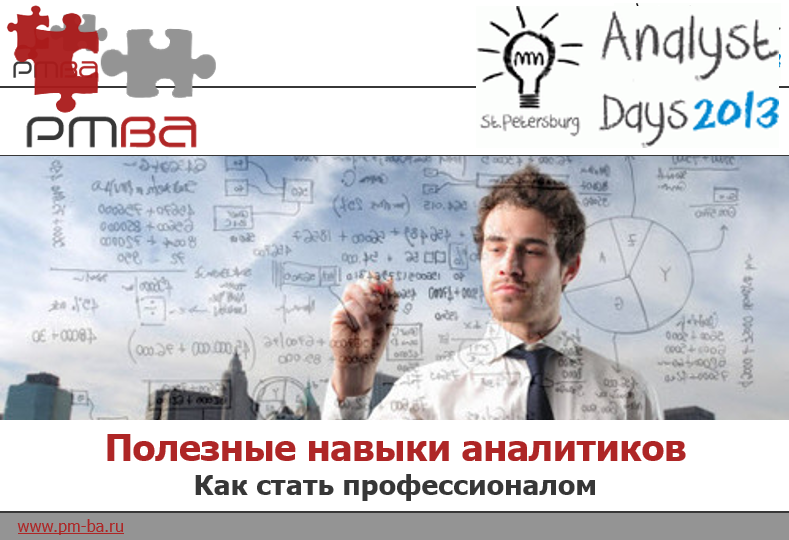
')
A video report is also available:
and presentation: www.slideshare.net/VLDCORP/ss-21928819
My topic is useful analytic skills and aims to show you professional development opportunities in the field of business analysis.
Briefly about yourself
Maria Bondarenko, director of the Belarusian-German-Russian company GP software for developing software in the field of tourism; has been working in IT for more than 10 years
Sergey Bondarenko, works in the company Itransition (almost 1000 people), is engaged in management tasks (including in the divisions of analytics)

Objectives of the report
What do you want to show and tell in the report:
For beginners (analytics experience less than a year) - to give a general understanding of the industry, what skills may be needed and what are the development horizons
For experienced analysts: open unknown horizons that you could not see in the context of your tasks, and also show the power and breadth of the area of business analysis

To the question “Which of the analysts received professional education?” Only a few of those present at the conference answered positively.
Much more came from testing and development. Some even came from a linguistic university.
In general, the field of business analysis is now quite young.
And not so much receive vocational education in this area. And just as it turns out, it becomes so: there is such a vacancy, you decide “why not try it?” And now your business analyst career begins.
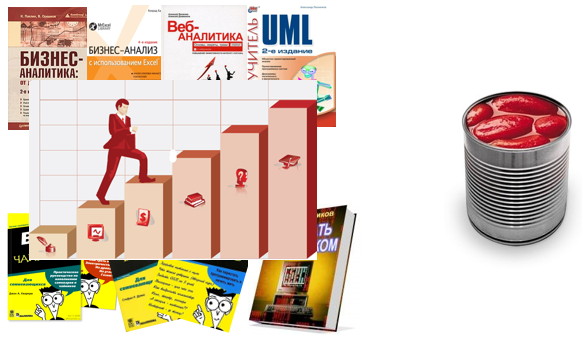
What happens next? Then you start to work, perform some tasks and walk up the career ladder within the company. But your range of tasks is usually limited to only those projects that this company performs. Accordingly, if you come to one company and ask: “There are business analysts here, and what are you doing? And what is business analysis? ”Or you will come to another company and ask,“ What is business analysis, ”you can get 2 completely different answers.
In order to somehow improve this situation, you are trying to read books, read information on the Internet and type this experience somehow, but, nevertheless, again this all happens rather chaotically. Accordingly, such a hodgepodge occurs in your head, you are boiling in your own juice and lacking a comprehensive understanding of the business analysis context.

I repeatedly saw at interviews when specialists came to me to get a job (and in our company the position in which the project manager and analyst are combined) was spread and the guys said: “In general, I already know everything in business analysis, now I want to try myself in field of management. In general, they come to the fact that seeing only some subdomain of business analysis, they conclude that this is all that can be. The second possible reaction is that you do not know where to go next, you feel sad, you are not efficient enough on your projects and you may not even know that there are any means to increase this efficiency to increase the context of understanding this area.
Next, we proceed to this.

I would like to show you the possible roles of a business analyst in projects, possible areas of activity and the necessary skills, personal characteristics and tools that may be useful to you. Below, I will outline what may be needed, because For each of them, you can arrange a separate report or a separate training, so further I recommend that you dive into areas that you find interesting for yourself.
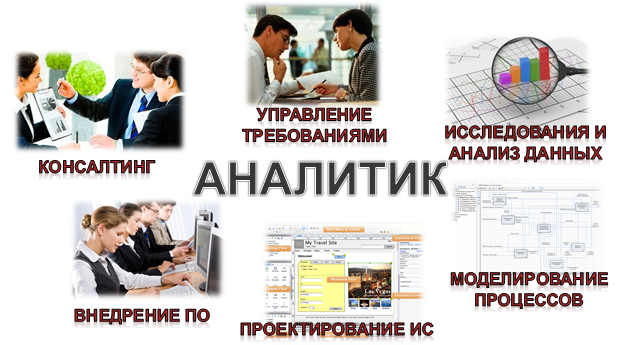
In the process of preparing the report, it turned out to highlight several areas in which business analysts work:
• Requirements Management
• Research & Analysis (Research and data analysis)
• Processes Engineering (Process Modeling)
• Modeling & Design (IP Design)
• Delivery (Implementation)
• Consulting (Consulting)

The most obvious is requirements management . This is a person who collects requirements, who analyzes them, manages changes and who ensures that all project participants are aware of current requirements, that they are communicated correctly to the development team and that the result of the work corresponds to the wishes that the client originally had . But that's not all.

There are about 6 areas that analysts do. The next area is data research and analysis : a common task of working with data. Analyze which systems are already on the market with similar functionality, find these systems, compare them, provide information which one is better suited for the current project tasks. The second cut of the analyst’s role is the analysis of the system’s performance and the development of certain conclusions. Those. general analytical tasks.
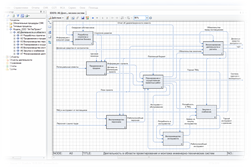
The next possible role of analytics on projects is the area of process modeling . Not always business analysts who work in IT and are directly involved in developing and managing requirements and designing systems, know that, in general, the primary sources of their tasks lie in the area of business processes, in the area of client business. The client somehow performs these or those operations now and the software is not required by him now. But in the process of analyzing our current situation, we can conclude that the processes are not optimal, that they need to be reorganized and, accordingly, the task is to develop software. Here, actually, who will help the client look at his business processes, describe and transform them into a more optimal state? This is also a business analyst task.
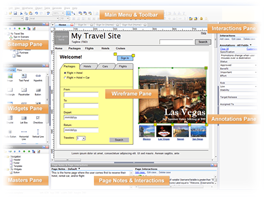
The next area of business analyst activity is the design of information systems . And the design is different. And depending on the skills of analysts, you can dig deeper into this area or less. For example, the simplest level of system design is to sketch mockups or prototypes of screens and then transfer this to usability specialists or designers so that they can work out in more detail. On the other hand, if you have a deeper knowledge of these skills, for example, usability, for ease of use, you can combine the role of usability specialist. Those. In principle, this may be part of the business analyst’s work.

The next possible area of activity for analysts is software implementation , in particular, when a product is already developed, this product needs to be implemented, it is necessary to customize it at the client (if we are talking about large systems). This is a field of activity that requires special skills and abilities.

And consulting . The deeper you work in the industry, the better and higher the practical skills, the more complex tasks you can assign and the more you can act as an expert in the eyes of the client, and not just a conductor of his requirements to the developers. Moreover, consulting may not even be directly related to the implementation of the project. Just consult the client on technology issues on business issues. This is also the area of business analyst activity.

In connection with this range of possible tasks, certain skills are highlighted that allow you to perform them more professionally. The classic division of skills is hard and soft. Hard skills are knowledge of tools, technologies, techniques or notations, or what you can learn. Soft skills are personal and interpersonal characteristics that are given to him from birth, but they also develop and they can also be trained and according to them there are methods of development.
Within these skills and the cut of possible roles of analyst on projects, the following dependencies can be identified (see table).

For convenience, we have divided all skills from the hard skills group into 7 groups: basic competencies, theory and analysis techniques, business fundamentals, knowledge of IP development, documentation, additional competencies, foreign languages. At the intersections of roles and competencies, it is indicated for which tasks the analyst needs certain skills.
In foreign languages: question marks are because, in principle, can be a smart analyst, to work in the local market and it will be enough for him only the Russian language to perform their work. But given that the area of business analysis is quite young and there are not so many literatures, forums and communities in Russian in which you can learn information, of course, knowledge of foreign languages will allow you to develop better and get more professional knowledge than you know only 1 language .
As for soft-skills, they were divided into several groups and criteria were defined, for which roles certain soft-skills are most important.
Below we will tell you more about all the hard and soft skills listed.
We describe hard-skills that involve purely technical skills. They are the easiest to train and are important enough, because underlie the effective work of the analyst.
What are the core competencies?
This is a series of things that you must learn before you begin to step into the field of business analysis. They will allow your thoughts to clothe in a certain form. These are fairly simple things, but basic ones that no one will teach you separately. It is understood that you should have this.
a. Business ethics

First, general business ethics, telephone communication skills, written correspondence skills. Namely, such tasks as: how to write a letter (start with a greeting, at the end put the final phrase, prompting the client to action, and signature), how to communicate with the client by phone. This, of course, must be known to you in advance. Why am I talking about this — I personally saw situations when analysts came to the project and the letters looked like this: “Can you send us the actual documentation on the project?” Neither “hello”, nor “goodbye”. It's just not beautiful. This is a basic skill that you should have and about which you don’t even need to speak.
b. Internet skills

The next skill is the ability to work on the Internet, to work with instant messengers (Skype, for example, is very popular now). Due to them, you reduce the distance and the client can contact you online. In Skype, you can form a group discussion, the entire team to connect to communicate with the client and then questions about the project are resolved faster. You should also know what a screen demonstration is, how to send files, etc.
c. Teamwork

The next block is the ability to work together. Knowledge of tools like Google Drive will help you.
Goggle Drive is an affordable, free tool through which it is possible to exchange documents with the client and the development team. If you don’t have a collaboration tool installed in your company, this is the easiest choice to give customers access to documents. And what is more important - you can simultaneously and jointly work on the same document. We use this technique - we open with the client a document with requirements and discuss what and in what order should be implemented. You change the priorities in your document and the client sees it on your screen in a couple of seconds.
d. Online conferences
In the same group - tools for online conferences. It is very useful when the analyst does not just send documents to the client, but demonstrates, in particular, intermediate versions of the system's operability, shows prototypes. For this you will need some kind of playground. Of course, there is an option that you come to the client, if he is in the same country and city. But often we work with western customers or remote teams. These online conferencing tools include GoTo Meeting and GoTo Webinar (these are from one series), WebEx and others. And they can be useful not only for the presentation of results, but also for collecting requirements.
e. Wiki storage
Another tool like MediaWiki may be useful. This is an online library, like the well-known Wikipedia, which you can locally deploy to your client and the whole team with the help of your administrator. It is possible to keep records in it and it’s good that you don’t need to save files to the repository to keep track of versions, send to colleagues, you can’t forget the file - the actual content is always available. For example, a user manual or specifications can be written in MediaWiki.
f. Read and print speed

Another block of basic competencies of hard-skills is speed reading and typing (although there may be disputes whether this can be attributed to soft-skills).
Analytics need to process a lot of information: on the one hand, read a lot (study and reflect), and on the other, write a lot (record results), so you will be extremely useful in your professional career if you train these 2 skills. For example, you can compare - the average typing skill is 100 characters per minute, I type at a speed of 400 characters per minute. If everything is clear what to write in the document and you just need to fix the agreement in words, write the protocol of the agreement with the client, then you can imagine - it takes 4 times less time for me than the average specialist. Accordingly, by increasing this skill in yourself, you make yourself more efficient and save time on your projects.
g. Office tools
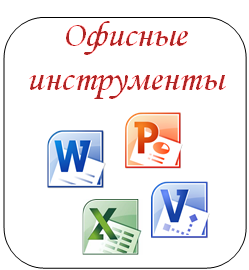
Also within the framework of basic skills, I would like to point out a number of tools, such as office tools (Word, Excel, PowerPoint and Visio), which allow you to present the results of your work in a high-quality and visual manner. If you know how to open a Word document and know how to type text there, but you do not know how to customize the styles of headings and tables, arrange notes, use templates and properties of the document. Or you can open an Excel document and know what a spreadsheet is, but do not own formulas, macros, conditional formatting, then believe me, you still have where to dig within these tools. Just for the sake of interest, you can open a certificate about the program or some kind of test for this program, and you will learn a lot that, it turns out, you didn’t know before. Accordingly, there is always room for development.
h. Visualization
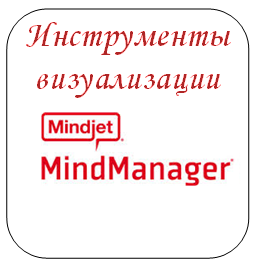
The next tool is MindManager. It is also quite a useful program that relates to basic skills and allows you to structure information in the form of a mind map.
i. Graphic editor

Analysts can also be useful and graphic editors - not only complex Photoshop, but also, for example, the classic Paint. There is an even more powerful program - SNAGIT - I recommend.
j. Multimedia Editors

Of course, you can use PowerPoint for presentations, but in a modern environment the Prezi tool is becoming quite popular. Presentations in it are more interesting and interactive. Plus, if you master the creation of video clips, in particular, the program Camtasia Studio, which allows you to record a video series of applications demonstration, it will be useful in terms of what the client can not always give you time now, but you can provide him with video -file, and the client is more likely to look at it than if he would independently click on the buttons of the system.
The next block is theories and techniques of business analysis. These are the skills that help you become a business analyst directly.
In this context, knowledge and skills in the areas of:
• Requirements Management
• Change management
• Development of project artifacts
• Appropriate toolkit
a. Requirements Management

The first block of knowledge is requirements management. Here it is important to know how to identify sources and how to identify requirements, and what to do with them after that: analyze, specify (document), check.
b. Change management
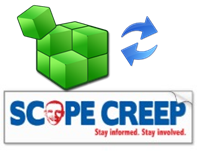
This is a requirements management subunit, but I carried it out separately to sharpen your attention on it. The fact is that it is very important to understand traces (there is a separate report on this topic at the conference). It is important to know how to manage the scale of the project.
a. Project Artifacts

Next - the ability to describe the Vision, Software Requirements Specification, prepare a user manual. Sometimes I heard the opinion that the analyst should not write user guides, that this is the work of a technical writer. I think this is quite a narrow view of the world, because, in general, the task of the analyst is to contribute to the creation of a product that will be successful and useful, and the technical writer is not always selected in the team. Those. No need to "outweigh the dogs" on each other. The analyst can write instructions for working with the system and user documentation most effectively. Even if he does not write, he should have a common understanding of what user documentation is and how it differs from baseline documentation and specifications.
b. Tools
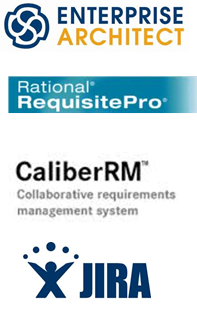
In the field of theories and analysis techniques, tools for requirements management are also highlighted, such as Enterprise Architect, Borland CaliberRM (a separate stand was presented at the conference, and a report was read), etc. Non-specialized tools are also used to manage requirements - Excel, Jira
What can be useful to you in the knowledge of the basics of business for your development?
a. Basics of Economics

You will need knowledge of what TCO (total cost of ownership), ROI (Return on Investment), EBIDAT (Earnings before depreciation and taxes), ABC (Activity-Based Costing), etc. These terms should be studied, since you, as a business analyst, should contribute to business success, and understanding the fundamentals of the economy (understanding what software is made for and how the effectiveness of software implementation will be evaluated) is crucial for the analyst to make the right decisions. You need not just to collect and manage requirements, but to do it within the limits of the project’s limitations (which are often associated with the economy — resources are not as limitless as money).
b. Business Process Engineering
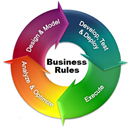
The skill of developing business processes can also be useful. And this also includes the understanding that business processes are basic and auxiliary, and also that their design occurs in the AS IS (as it is now) and TO BE paradigms (as recommended or as it should be).
I don’t dwell more for my purposes - to designate the points of development of the analyst, and then it is supposed to independently study these areas.
c. Process modeling notation
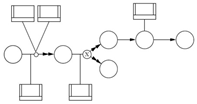
For engineering business processes, you will need knowledge of certain notations in which you will describe the processes. Of course, they can be described in simple terms, but the following business process modeling notation is also quite common: BPML (Business Processes Modeling Language), IDEFx, CFF (cross-functional flowcharts) and regular flowcharts.
d. Tools


The relevant tools for business process description and economic planning (which I met) are BPWin and Business Studio.
An analyst who develops information systems must possess techniques and methods for their development.
a. Fundamentals of architecture
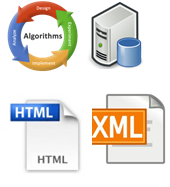
The first block - the basics of architecture - a general understanding of what IS is, understanding client-server technology and building databases, knowledge of the device sites (including understanding HTML, CMS devices, knowledge of ready-made CMS), and also understand in protocols and data transfer formats (XML, CSV, and so on).
b. Design
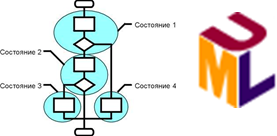
notation You may be useful design notation such as, UML, DFD, flowcharts.
c. Ergonomics

In addition to general knowledge of the development of IP, you will need knowledge of ergonomics (usability), and in this plan pay attention to standards such as web-style guide, mobile-style guide. A development of IP for iPhone and Android has a set of best practices and standards of requirements for how mobile applications should be designed. In particular, on the AppStore you will certify an application to an owl, and if it does not meet the standards, it will not be missed.
d. Tools

The toolkit allows you to design efficiently and conveniently from the point of view of the project and from the point of view of those for whom this project is being done. In particular, these are prototyping tools (Balsamiq Mockups, Axure, JustInMind - including mobile interfaces). MS Visio is also used for this purpose.
a.

The next block of skills is documentation. Analysts write documents and they (documents) must be literate from the point of view of language, the correct use of technical style, competent writing, and from the point of view of design. This factor is determined by how nice it is to take your document in your hands, how neatly and uniformly it is designed, how well prepared it is for printing. This, by the way, is a very important point - 90% of the documents that external analysts send me when trying to print (especially Excel tables) are displayed on 10 sheets in a chaotic manner. Then you have to manually try to collect them, which is almost impossible. But the fact is that Excel by default does not format the page for printing. Analysts should know that there are special settings for the structure and appearance of the page,in which the format of printing, the order of pages, their numbering is set. Pay attention to this - have prepared a document, then printed out and saw if it is convenient to use it or if you need to put the document in order.
b. Ergonomics
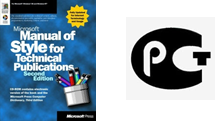
For the paperwork there is also a set of standards in the field of ergonomics (or usability, as is now more popularly expressed). In particular, among technical writers, one of the proven standards is MS Manual of Style. At the moment there are more than 400 pages and it is very good in terms of how to write English-language technical documentation - which terms to use (for example, “click the button” or “click on the button”), how to design, structure.
c. Tools
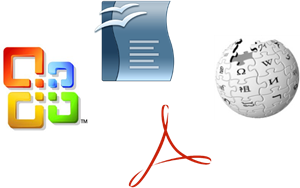
And of course, the preparation of documents. This may be MS Word, OpenOffice (for Linux). Programs for generating PDF documents (Acrobat) are also required. And the Wiki is also useful for documenting. In particular, knowledge of wiki-markup (a specific language that is quickly mastered) will allow you to better understand, In which case the document should be drawn up in Word, and in which case - in the Wiki.
The additional hard-skills competencies that I would like to draw attention to are the following.
a. Fundamentals of management The
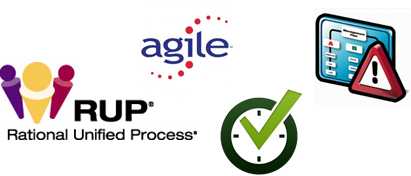
analyst somehow always accompanies the manager on the project and somewhere shares with him the responsibility, somewhere he can replace, somewhere, communicating with the client, he somehow makes decisions on the inclusion of requirements in the project. Those.it is, on the one hand, analytics, on the other, management.
b. Knowledge in the subject area

Here it can be very useful (and more often it can also be fundamental) - this is a domain examination. Whichever project you start doing, specify in which domain it will be executed - it could be finance, insurance, tourism - and carefully read this subject area. Of course, in terms of overall development, it is impractical to grasp all areas, since There are a lot of them, and it is useful to dive into the domain in which you run the project.
c. Applied expertise
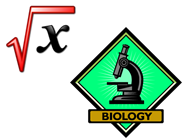
As an additional competence, applied expertise is important. Moreover, a different application area may be important from project to project. For example, if the project is carried out in the field of tourism, then knowledge of the "traveling salesman problem" in graph theory, which is studied in applied mathematics, would be useful. Namely, you need to understand how to deliver tourists from the airport to hotels, provided that the team is a national team and hotels are located in 10 points of the city. With this expertise, the analyst will be able to offer a more competent solution than he will not be in the subject.
d. Business Toolkit

Knowledge of the tools that a business uses, such as ERP systems, CRM systems, etc., can be useful.
Also in the group of additional competencies we included foreign languages, which were mentioned above. In addition, it should be clarified that it is highly recommended to learn English at a decent level - at least because it will allow you to understand a lot of useful literature that is published in English, but, unfortunately, is not always translated into Russian, and also communicate on forums with colleagues Analytics from other countries.
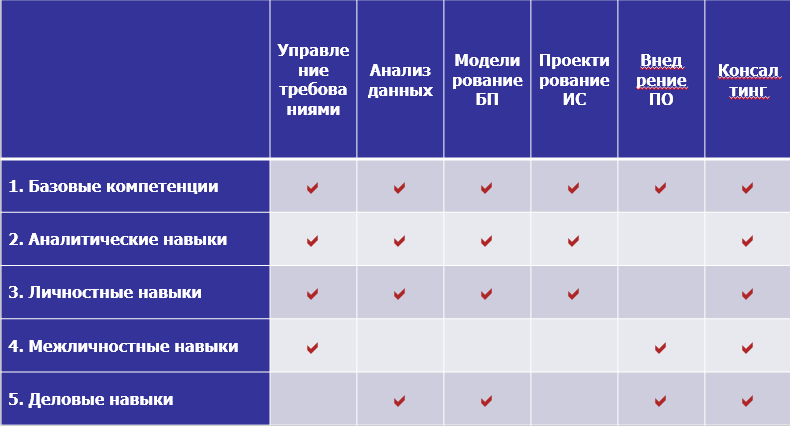
Next, I propose to go to the review of personal characteristics that develop more difficult and longer. Let me remind you that my task is to pay attention to key skills. Development Tips - read relevant literature, attend trainings, try in practice.
So, among the soft-skills are important, firstly, basic skills.

Among them, first of all, it is:
• independence,
• learning,
• good memory,
• clarity of information.
a. Independence
Analysts rarely lead a project in large groups. Usually, the analyst either completely leads the project, or, even if he works in a team of analysts, all the same, each analyst is responsible for one zone. Accordingly, the analyst should be able to independently conduct the entire project.
b. Trainability The
work of an analyst is always research, i.e. a large amount of information passes through it and you need to quickly grasp it, process and transmit it.
c. Good memory is
needed for the same reasons as learning - you have to keep many details in mind.
d. Clarity of information
when transmitting information to the customer or the developer should not be a misunderstanding. Information must be clearly structured.
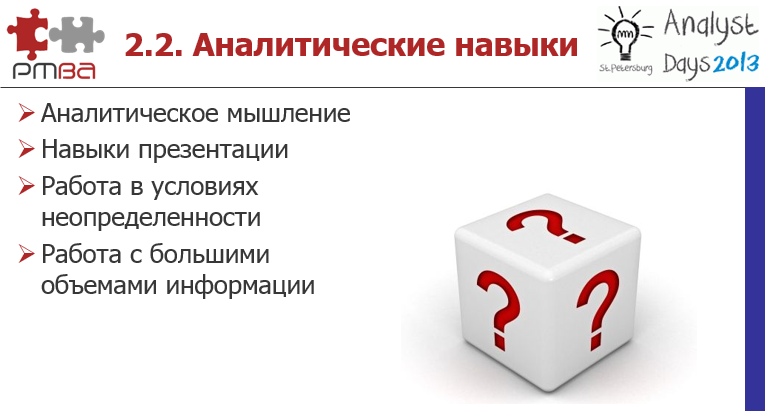
First of all, this is analytical thinking, which implies the ability to be critical of the situation, the ability to transform what you get into a data structure, and not directly transfer what is received at the input.
Also, the analyst requires the ability to work with large amounts of information, the skill of working in conditions of uncertainty and presentation skills.

a. Activity
For an analyst, it is important to be active: as the project moves forward, it must take an active position, find out the requirements. Also, during the acceptance of project results, he cannot afford a passive position.
b. Pedantry
Analysts should be attentive to details and should not lose sight of any critical things. Those. the phrase "and so it will come down" is not about the real analyst - he must be different in character.
c. Creativity
The fact is that analysts always not only receive information, but also create something: either they determine the reengineering of processes (then you need to think of the most optimal way of it), or think up new systems (ie, creative from scratch) .

a. Sociability
In the area of interpersonal skills for analysts, first of all, sociability, sociability, ability to ask questions and correctly convey information, the ability to tune in to a client's excitement are important.
b. Teamwork
It is also important that the analyst is able to work in a team. Those.Someone sullen, who likes to work with computers, rather than with people, is unlikely to approach the position of the analyst. In this case, I would recommend to develop skills in communication and teamwork.
c. Organizational skills and
skills for self-organization and team organization are also quite important for the analyst.

Further, we will explain what should be included in the analyst's business skills:
• Customer focus
• Business acumen
• Negotiation skills
• Stress resistance
In particular, many books have been written on the subject of negotiation skills. It is highly recommended that analysts know how to effectively talk and persuade about something (for example, often some features cannot be included in the release, and in such a situation the analyst needs to be a diplomat).
On stress tolerance, let me remind you once again - analysts, as a rule, work in conditions of uncertainty and this quality will be very useful.
How can I increase the efficiency of the analytic? I can give 2 basic tips besides the basic tools.

First of all, quite good analyst assistants are all kinds of collections (icons, graphic primitives). For example, you found what you like and saved it to disk or asked the designer to draw. In this case, it will be easier then to prepare the documents and draw prototypes using these elements (i.e., you will not look for the design, where to get or where to draw - the images will look nice and neat).
Also helps analysts letter templates and functional patterns. Where do they come from? After completing previous projects, save the results (best practices) to your knowledge base. Thus, from project to project, you will accumulate not only experience in your head, but also a good base of ready-made developments that can be used in future projects for better efficiency.
Also a good source of knowledge is analytical materials (for example, market reviews).

And the second clue that can increase your efficiency is an objective assessment of yourself. You need to understand how well you own certain analyst skills (you can use the above list to test your hard and soft skills). This test will allow you to understand where to go next.
In life there are a lot of examples of when people consider themselves cool, but they are not. Most often, self-esteem is overstated. But when an analyst believes that he is cool, he cannot work more efficiently. Remember the words of Socrates, "I know that I do not know anything," and their continuation: "But others do not even know this." If a person believes that he is already at the top, then you will not climb further up. For example, with regards to MS Word, 90% say they own it “freely,” although they do not know how to use either fields or macros.

The fact is that as soon as you realize the depth of your ignorance, then you can develop a development plan. And if you honestly do it, then your efficiency increases most quickly. Such a plan allows you to constantly run forward.
Never stand still, because who is standing still, inevitably rolls back. And in the modern world it is in principle not realistic.

1. Determine the areas of activity you are interested in
. 2. Record the current level of skills
. 3. Form development goals and achievement criteria
. 4. Determine ways to achieve goals. A
large number of areas of activity, tools that can be useful to analysts have already been identified. Not the fact that you own all this and that you need them all right now. But, nevertheless, from the listed list (and, perhaps, and something else - I do not pretend to be complete), determine what is most interesting to you.
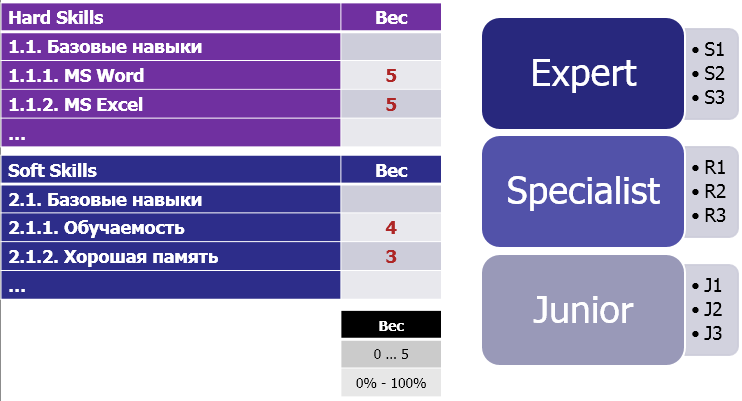
At this step, you can write out all possible skills and tasks of analysts in a table like the attached one (the presentation file is available on the AnalystDays-2012 conference page ). Then you should put a weight in front of each skill - how much for you (and / or for the company - depends on the level at which the plan is built) a particular skill is important. You can use a scale from 0 to 5 or from 0 to 100 (in the example, a scale of 0..5 is used). In principle, the same classification can be used in your career.
Our company uses gradation into 3 levels of specialists - Junior, Specialist, Expert - and inside them there is a division into 3 steps from R1 to R3. For each of these levels, certain criteria are introduced, what skills they need and at what level of proficiency.
As recommendations: the plan should take into account both the skills of wide application. And highly specialized skills. But it is worth considering everything. And you should also add to the table those additional skills that, although not fundamental in the work of the analyst, however, simplify life and make its work more efficient.
Also, when drawing up a plan, the following criteria should be taken into account: individuality, binding to the certification system, concreteness, measurability, consistency with management.
As a result, on the basis of this classification, you can not just make a personal development plan, but at the same time determine which career opportunities you have arising from the development of certain skills.

When drafting such a development plan, the question arises - speaking of analysts and requirements for them, is it correct to mix analysts engaged in various tasks or not? And is it worth to be sprayed on everything or to concentrate on some narrow field of activity? The question is quite philosophical, and everyone answers it independently. For example, there are personal preferences for modeling business processes and therefore I want to study this area most deeply - no one will prevent you from doing this. Or someone would like to explore various areas of business analysis more widely, which will also have a good effect on your career, because You will understand where and what techniques can be used, be able to flexibly select them depending on the characteristics of your project.
And I would like to cite a few points, which can be useful for analysts with a broad outlook.
The fact is that with such a plan there is practically no limit. Most likely, the whole life will not be enough to master the entire width of the topic from and to. All the same, you will concentrate on some of its subsets. However, the already studied subset is valuable for the market and you just have to go and coordinate it with your employer.
Those. wide horizon of skills - it is useful, interesting, profitable.

After determining the weights, you should determine what current level of skills and knowledge of technologies and tools you have. One of the fairly convenient methods of assessment is the analogue of the assessment of knowledge of foreign languages (from Basic to Intermediate and Advanced). Each of these levels is assigned its own score from 0 to 5. Then you calculate the total amount of points as the sum of weighted scores.

Then you fill in 2 more columns in the table of the plan - what level of knowledge and skills you expect in your home in a year and a month. This approach is somewhat close to the current trend of unification, when you subordinate your development to numerical measurements (in fact, you accumulate points). There is still room for development, how this table can be optimized, which “buns” can be presented to yourself for achieving one or another level.
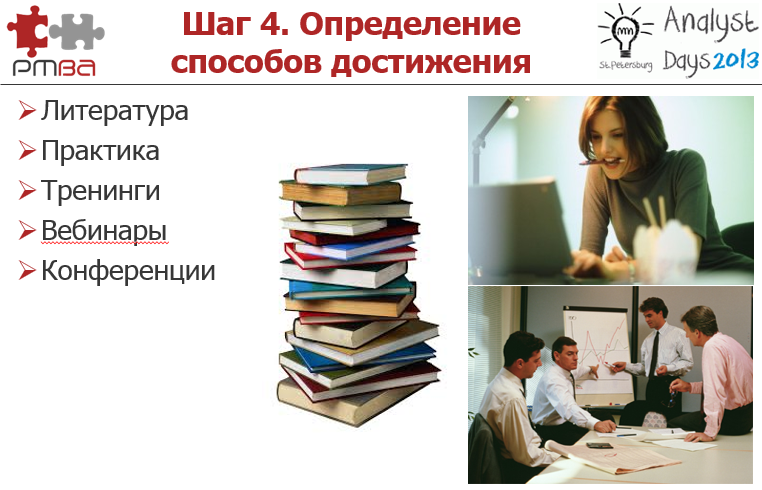
After that, you determine how to achieve the goal. For each item you plan to improve, you define literature, trainings, conferences, etc. You must have a clear understanding of what you are planning to do in the coming month and next year in order to develop in business analysis.
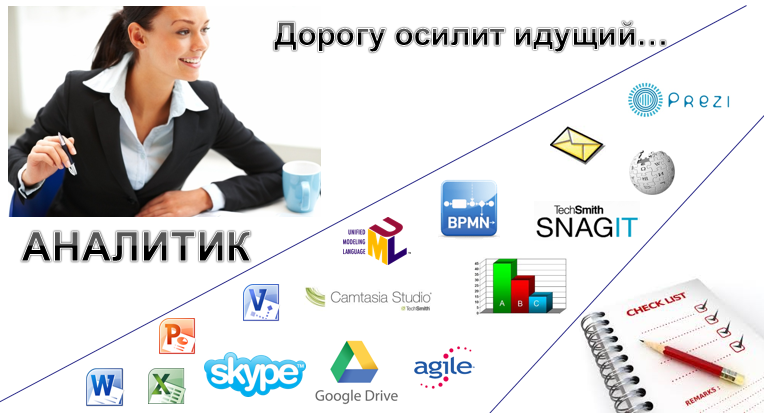
So, business analysts can have a lot of skills and knowledge, they can be different, they can be applied in different forms on your current projects. But if you feel that you have already reached the ceiling and that you know everything in the framework of the work that you are doing right now on projects, do not despair in any way - try to recall today's report, try to look more broadly at the world and think that I still do not know and where I can still develop, where I can go. Definitely, it will be useful to you from a career point of view, and your employer will also appreciate it. Which means you will be more successful as a professional in your IT career.
We should start by agreeing with a team of analysts on the equal representation of the quality of work among all members. For example, for me, one of the criteria for analyst work (not the main one) is the quality of the documents they provide. At the same time it is important for me that the document be beautifully designed, meaningfully and logically structured so that there are no jumps from section to section, etc. Accordingly, we take this particular atomic unit and with the analyst we argue that the quality of the document should be such, and he answers you that he did not even think about it. For example, there is no page numbering, okay. He thought the main thing was to write the text. Thus, having sat down together and having spoken these moments with him, we come to a common understanding of the quality of the document.
Accordingly, it is necessary to go through all the steps of the analyst’s work and talk through the quality criteria.
By assessment, I can say the following: we undergo periodic certification (1-2 times a year), the assessment for which consists of several criteria. Analysts are, first of all, communicators, i.e. they receive information from customers and pass it on to developers. A very important evaluation criterion is what the client thinks about interaction with the analyst: how quickly he responds to requests, how clear and understandable information he provides to the client, and how effective he is in interacting with the client. This questionnaire is completed by the client. A similar questionnaire is filled in by the developers (i.e., the project implementation team): how available is the analyst to them, how much do they understand the documents provided to them, how comfortable is it for them to work with this analyst on the project.
This is one of the point of evaluation of analysts, and very important, because he is a translator between the client and the developer, and if there is a weak link at this stage, then no matter how cool he writes and writes, he has not achieved his goals.
The second point is the effectiveness of the project. Of course, not only the analyst is taken into account here, but, nevertheless, we make an assessment of the entire team as a whole. But since the analyst was a translator of requirements and, together with the team, he formed what the product should do, this is also a rather important characteristic.
The third point - if possible, this is an expert assessment of the documents, requirements that the analyst makes. For example, within six months he wrote the requirements, but some of them did not include in the basic requirements or forgot about them. Or in relation to specifications - as far as they are clear, specific, consistent. This way you can expertly evaluate these documents. Not always the opportunity. Usually only the customer or the development team can say something about him.
Why are domain knowledge related to additional competencies? As I see it, this is the main thing: the analyst may draw bad diagrams, but he must understand what he is doing. There are a lot of people who draw beautiful graphics and UML diagrams, and those who do not understand the essence of the work and do stupid things are the majority.
Agree with this position. However, Sergei and I in the process of preparing the presentation argued quite a lot about the grouping of skills for ease of presentation and understanding by analysts. The same basic skills are the foundation that does not allow to become an analyst, it only allows to start understanding in this industry. Therefore, it may not be domain expertise. Of course, for the successful implementation of projects without it absolutely nowhere.
I started my career just as a technical writer, so everything is very close to me, I understand very clearly what you are talking about. According to my feelings and the way I performed my analytical functions, having a technical writing base, and comparing it with analysts who do not have this base, I still think that analysts should have the skills to write technical documentation. This makes you more professional.
On the fact that something can be divided and outsourced, my entire report can be broken into pieces and say, for example, that the design of business processes should be given to a specialist in business process modeling (I have met such a specialist who did which none of my business analysts could do). But this is just proof that the better you delve into those areas that are indicated in the report, the better your result will be and the more you will cause a wow-reaction of everyone around you.
Ps . Meet Maria with Sergey is also possible at future Analyst Days conference series.

')
A video report is also available:
and presentation: www.slideshare.net/VLDCORP/ss-21928819
My topic is useful analytic skills and aims to show you professional development opportunities in the field of business analysis.
Briefly about yourself
Maria Bondarenko, director of the Belarusian-German-Russian company GP software for developing software in the field of tourism; has been working in IT for more than 10 years
Sergey Bondarenko, works in the company Itransition (almost 1000 people), is engaged in management tasks (including in the divisions of analytics)

Objectives of the report
What do you want to show and tell in the report:
For beginners (analytics experience less than a year) - to give a general understanding of the industry, what skills may be needed and what are the development horizons
For experienced analysts: open unknown horizons that you could not see in the context of your tasks, and also show the power and breadth of the area of business analysis
Where do analysts come from?

To the question “Which of the analysts received professional education?” Only a few of those present at the conference answered positively.
Much more came from testing and development. Some even came from a linguistic university.
In general, the field of business analysis is now quite young.
And not so much receive vocational education in this area. And just as it turns out, it becomes so: there is such a vacancy, you decide “why not try it?” And now your business analyst career begins.
How are analysts developing?

What happens next? Then you start to work, perform some tasks and walk up the career ladder within the company. But your range of tasks is usually limited to only those projects that this company performs. Accordingly, if you come to one company and ask: “There are business analysts here, and what are you doing? And what is business analysis? ”Or you will come to another company and ask,“ What is business analysis, ”you can get 2 completely different answers.
In order to somehow improve this situation, you are trying to read books, read information on the Internet and type this experience somehow, but, nevertheless, again this all happens rather chaotically. Accordingly, such a hodgepodge occurs in your head, you are boiling in your own juice and lacking a comprehensive understanding of the business analysis context.
What can this lead to?

I repeatedly saw at interviews when specialists came to me to get a job (and in our company the position in which the project manager and analyst are combined) was spread and the guys said: “In general, I already know everything in business analysis, now I want to try myself in field of management. In general, they come to the fact that seeing only some subdomain of business analysis, they conclude that this is all that can be. The second possible reaction is that you do not know where to go next, you feel sad, you are not efficient enough on your projects and you may not even know that there are any means to increase this efficiency to increase the context of understanding this area.
Next, we proceed to this.
Maybe better?

I would like to show you the possible roles of a business analyst in projects, possible areas of activity and the necessary skills, personal characteristics and tools that may be useful to you. Below, I will outline what may be needed, because For each of them, you can arrange a separate report or a separate training, so further I recommend that you dive into areas that you find interesting for yourself.
What is an analyst?

In the process of preparing the report, it turned out to highlight several areas in which business analysts work:
• Requirements Management
• Research & Analysis (Research and data analysis)
• Processes Engineering (Process Modeling)
• Modeling & Design (IP Design)
• Delivery (Implementation)
• Consulting (Consulting)
Requirements Management

The most obvious is requirements management . This is a person who collects requirements, who analyzes them, manages changes and who ensures that all project participants are aware of current requirements, that they are communicated correctly to the development team and that the result of the work corresponds to the wishes that the client originally had . But that's not all.
Research and data analysis

There are about 6 areas that analysts do. The next area is data research and analysis : a common task of working with data. Analyze which systems are already on the market with similar functionality, find these systems, compare them, provide information which one is better suited for the current project tasks. The second cut of the analyst’s role is the analysis of the system’s performance and the development of certain conclusions. Those. general analytical tasks.
Process modeling

The next possible role of analytics on projects is the area of process modeling . Not always business analysts who work in IT and are directly involved in developing and managing requirements and designing systems, know that, in general, the primary sources of their tasks lie in the area of business processes, in the area of client business. The client somehow performs these or those operations now and the software is not required by him now. But in the process of analyzing our current situation, we can conclude that the processes are not optimal, that they need to be reorganized and, accordingly, the task is to develop software. Here, actually, who will help the client look at his business processes, describe and transform them into a more optimal state? This is also a business analyst task.
IP design

The next area of business analyst activity is the design of information systems . And the design is different. And depending on the skills of analysts, you can dig deeper into this area or less. For example, the simplest level of system design is to sketch mockups or prototypes of screens and then transfer this to usability specialists or designers so that they can work out in more detail. On the other hand, if you have a deeper knowledge of these skills, for example, usability, for ease of use, you can combine the role of usability specialist. Those. In principle, this may be part of the business analyst’s work.
Software implementation

The next possible area of activity for analysts is software implementation , in particular, when a product is already developed, this product needs to be implemented, it is necessary to customize it at the client (if we are talking about large systems). This is a field of activity that requires special skills and abilities.
Consulting

And consulting . The deeper you work in the industry, the better and higher the practical skills, the more complex tasks you can assign and the more you can act as an expert in the eyes of the client, and not just a conductor of his requirements to the developers. Moreover, consulting may not even be directly related to the implementation of the project. Just consult the client on technology issues on business issues. This is also the area of business analyst activity.
Hard & Soft Skills

In connection with this range of possible tasks, certain skills are highlighted that allow you to perform them more professionally. The classic division of skills is hard and soft. Hard skills are knowledge of tools, technologies, techniques or notations, or what you can learn. Soft skills are personal and interpersonal characteristics that are given to him from birth, but they also develop and they can also be trained and according to them there are methods of development.
Within these skills and the cut of possible roles of analyst on projects, the following dependencies can be identified (see table).
1. Hard skills

For convenience, we have divided all skills from the hard skills group into 7 groups: basic competencies, theory and analysis techniques, business fundamentals, knowledge of IP development, documentation, additional competencies, foreign languages. At the intersections of roles and competencies, it is indicated for which tasks the analyst needs certain skills.
In foreign languages: question marks are because, in principle, can be a smart analyst, to work in the local market and it will be enough for him only the Russian language to perform their work. But given that the area of business analysis is quite young and there are not so many literatures, forums and communities in Russian in which you can learn information, of course, knowledge of foreign languages will allow you to develop better and get more professional knowledge than you know only 1 language .
As for soft-skills, they were divided into several groups and criteria were defined, for which roles certain soft-skills are most important.
Below we will tell you more about all the hard and soft skills listed.
We describe hard-skills that involve purely technical skills. They are the easiest to train and are important enough, because underlie the effective work of the analyst.
1.1 Basic Competences
What are the core competencies?
This is a series of things that you must learn before you begin to step into the field of business analysis. They will allow your thoughts to clothe in a certain form. These are fairly simple things, but basic ones that no one will teach you separately. It is understood that you should have this.
a. Business ethics

First, general business ethics, telephone communication skills, written correspondence skills. Namely, such tasks as: how to write a letter (start with a greeting, at the end put the final phrase, prompting the client to action, and signature), how to communicate with the client by phone. This, of course, must be known to you in advance. Why am I talking about this — I personally saw situations when analysts came to the project and the letters looked like this: “Can you send us the actual documentation on the project?” Neither “hello”, nor “goodbye”. It's just not beautiful. This is a basic skill that you should have and about which you don’t even need to speak.
b. Internet skills

The next skill is the ability to work on the Internet, to work with instant messengers (Skype, for example, is very popular now). Due to them, you reduce the distance and the client can contact you online. In Skype, you can form a group discussion, the entire team to connect to communicate with the client and then questions about the project are resolved faster. You should also know what a screen demonstration is, how to send files, etc.
c. Teamwork

The next block is the ability to work together. Knowledge of tools like Google Drive will help you.
Goggle Drive is an affordable, free tool through which it is possible to exchange documents with the client and the development team. If you don’t have a collaboration tool installed in your company, this is the easiest choice to give customers access to documents. And what is more important - you can simultaneously and jointly work on the same document. We use this technique - we open with the client a document with requirements and discuss what and in what order should be implemented. You change the priorities in your document and the client sees it on your screen in a couple of seconds.
d. Online conferences
In the same group - tools for online conferences. It is very useful when the analyst does not just send documents to the client, but demonstrates, in particular, intermediate versions of the system's operability, shows prototypes. For this you will need some kind of playground. Of course, there is an option that you come to the client, if he is in the same country and city. But often we work with western customers or remote teams. These online conferencing tools include GoTo Meeting and GoTo Webinar (these are from one series), WebEx and others. And they can be useful not only for the presentation of results, but also for collecting requirements.
e. Wiki storage
Another tool like MediaWiki may be useful. This is an online library, like the well-known Wikipedia, which you can locally deploy to your client and the whole team with the help of your administrator. It is possible to keep records in it and it’s good that you don’t need to save files to the repository to keep track of versions, send to colleagues, you can’t forget the file - the actual content is always available. For example, a user manual or specifications can be written in MediaWiki.
f. Read and print speed

Another block of basic competencies of hard-skills is speed reading and typing (although there may be disputes whether this can be attributed to soft-skills).
Analytics need to process a lot of information: on the one hand, read a lot (study and reflect), and on the other, write a lot (record results), so you will be extremely useful in your professional career if you train these 2 skills. For example, you can compare - the average typing skill is 100 characters per minute, I type at a speed of 400 characters per minute. If everything is clear what to write in the document and you just need to fix the agreement in words, write the protocol of the agreement with the client, then you can imagine - it takes 4 times less time for me than the average specialist. Accordingly, by increasing this skill in yourself, you make yourself more efficient and save time on your projects.
g. Office tools

Also within the framework of basic skills, I would like to point out a number of tools, such as office tools (Word, Excel, PowerPoint and Visio), which allow you to present the results of your work in a high-quality and visual manner. If you know how to open a Word document and know how to type text there, but you do not know how to customize the styles of headings and tables, arrange notes, use templates and properties of the document. Or you can open an Excel document and know what a spreadsheet is, but do not own formulas, macros, conditional formatting, then believe me, you still have where to dig within these tools. Just for the sake of interest, you can open a certificate about the program or some kind of test for this program, and you will learn a lot that, it turns out, you didn’t know before. Accordingly, there is always room for development.
h. Visualization

The next tool is MindManager. It is also quite a useful program that relates to basic skills and allows you to structure information in the form of a mind map.
i. Graphic editor

Analysts can also be useful and graphic editors - not only complex Photoshop, but also, for example, the classic Paint. There is an even more powerful program - SNAGIT - I recommend.
j. Multimedia Editors

Of course, you can use PowerPoint for presentations, but in a modern environment the Prezi tool is becoming quite popular. Presentations in it are more interesting and interactive. Plus, if you master the creation of video clips, in particular, the program Camtasia Studio, which allows you to record a video series of applications demonstration, it will be useful in terms of what the client can not always give you time now, but you can provide him with video -file, and the client is more likely to look at it than if he would independently click on the buttons of the system.
1.2 Theories and techniques of business analysis
The next block is theories and techniques of business analysis. These are the skills that help you become a business analyst directly.
In this context, knowledge and skills in the areas of:
• Requirements Management
• Change management
• Development of project artifacts
• Appropriate toolkit
a. Requirements Management

The first block of knowledge is requirements management. Here it is important to know how to identify sources and how to identify requirements, and what to do with them after that: analyze, specify (document), check.
b. Change management

This is a requirements management subunit, but I carried it out separately to sharpen your attention on it. The fact is that it is very important to understand traces (there is a separate report on this topic at the conference). It is important to know how to manage the scale of the project.
a. Project Artifacts

Next - the ability to describe the Vision, Software Requirements Specification, prepare a user manual. Sometimes I heard the opinion that the analyst should not write user guides, that this is the work of a technical writer. I think this is quite a narrow view of the world, because, in general, the task of the analyst is to contribute to the creation of a product that will be successful and useful, and the technical writer is not always selected in the team. Those. No need to "outweigh the dogs" on each other. The analyst can write instructions for working with the system and user documentation most effectively. Even if he does not write, he should have a common understanding of what user documentation is and how it differs from baseline documentation and specifications.
b. Tools

In the field of theories and analysis techniques, tools for requirements management are also highlighted, such as Enterprise Architect, Borland CaliberRM (a separate stand was presented at the conference, and a report was read), etc. Non-specialized tools are also used to manage requirements - Excel, Jira
1.3 Business Basics
What can be useful to you in the knowledge of the basics of business for your development?
a. Basics of Economics

You will need knowledge of what TCO (total cost of ownership), ROI (Return on Investment), EBIDAT (Earnings before depreciation and taxes), ABC (Activity-Based Costing), etc. These terms should be studied, since you, as a business analyst, should contribute to business success, and understanding the fundamentals of the economy (understanding what software is made for and how the effectiveness of software implementation will be evaluated) is crucial for the analyst to make the right decisions. You need not just to collect and manage requirements, but to do it within the limits of the project’s limitations (which are often associated with the economy — resources are not as limitless as money).
b. Business Process Engineering

The skill of developing business processes can also be useful. And this also includes the understanding that business processes are basic and auxiliary, and also that their design occurs in the AS IS (as it is now) and TO BE paradigms (as recommended or as it should be).
I don’t dwell more for my purposes - to designate the points of development of the analyst, and then it is supposed to independently study these areas.
c. Process modeling notation

For engineering business processes, you will need knowledge of certain notations in which you will describe the processes. Of course, they can be described in simple terms, but the following business process modeling notation is also quite common: BPML (Business Processes Modeling Language), IDEFx, CFF (cross-functional flowcharts) and regular flowcharts.
d. Tools


The relevant tools for business process description and economic planning (which I met) are BPWin and Business Studio.
1.4 Development of IP
An analyst who develops information systems must possess techniques and methods for their development.
a. Fundamentals of architecture

The first block - the basics of architecture - a general understanding of what IS is, understanding client-server technology and building databases, knowledge of the device sites (including understanding HTML, CMS devices, knowledge of ready-made CMS), and also understand in protocols and data transfer formats (XML, CSV, and so on).
b. Design

notation You may be useful design notation such as, UML, DFD, flowcharts.
c. Ergonomics

In addition to general knowledge of the development of IP, you will need knowledge of ergonomics (usability), and in this plan pay attention to standards such as web-style guide, mobile-style guide. A development of IP for iPhone and Android has a set of best practices and standards of requirements for how mobile applications should be designed. In particular, on the AppStore you will certify an application to an owl, and if it does not meet the standards, it will not be missed.
d. Tools

The toolkit allows you to design efficiently and conveniently from the point of view of the project and from the point of view of those for whom this project is being done. In particular, these are prototyping tools (Balsamiq Mockups, Axure, JustInMind - including mobile interfaces). MS Visio is also used for this purpose.
1.5 Documentation
a.

The next block of skills is documentation. Analysts write documents and they (documents) must be literate from the point of view of language, the correct use of technical style, competent writing, and from the point of view of design. This factor is determined by how nice it is to take your document in your hands, how neatly and uniformly it is designed, how well prepared it is for printing. This, by the way, is a very important point - 90% of the documents that external analysts send me when trying to print (especially Excel tables) are displayed on 10 sheets in a chaotic manner. Then you have to manually try to collect them, which is almost impossible. But the fact is that Excel by default does not format the page for printing. Analysts should know that there are special settings for the structure and appearance of the page,in which the format of printing, the order of pages, their numbering is set. Pay attention to this - have prepared a document, then printed out and saw if it is convenient to use it or if you need to put the document in order.
b. Ergonomics

For the paperwork there is also a set of standards in the field of ergonomics (or usability, as is now more popularly expressed). In particular, among technical writers, one of the proven standards is MS Manual of Style. At the moment there are more than 400 pages and it is very good in terms of how to write English-language technical documentation - which terms to use (for example, “click the button” or “click on the button”), how to design, structure.
c. Tools

And of course, the preparation of documents. This may be MS Word, OpenOffice (for Linux). Programs for generating PDF documents (Acrobat) are also required. And the Wiki is also useful for documenting. In particular, knowledge of wiki-markup (a specific language that is quickly mastered) will allow you to better understand, In which case the document should be drawn up in Word, and in which case - in the Wiki.
1.6 Additional competences
The additional hard-skills competencies that I would like to draw attention to are the following.
a. Fundamentals of management The

analyst somehow always accompanies the manager on the project and somewhere shares with him the responsibility, somewhere he can replace, somewhere, communicating with the client, he somehow makes decisions on the inclusion of requirements in the project. Those.it is, on the one hand, analytics, on the other, management.
b. Knowledge in the subject area

Here it can be very useful (and more often it can also be fundamental) - this is a domain examination. Whichever project you start doing, specify in which domain it will be executed - it could be finance, insurance, tourism - and carefully read this subject area. Of course, in terms of overall development, it is impractical to grasp all areas, since There are a lot of them, and it is useful to dive into the domain in which you run the project.
c. Applied expertise

As an additional competence, applied expertise is important. Moreover, a different application area may be important from project to project. For example, if the project is carried out in the field of tourism, then knowledge of the "traveling salesman problem" in graph theory, which is studied in applied mathematics, would be useful. Namely, you need to understand how to deliver tourists from the airport to hotels, provided that the team is a national team and hotels are located in 10 points of the city. With this expertise, the analyst will be able to offer a more competent solution than he will not be in the subject.
d. Business Toolkit

Knowledge of the tools that a business uses, such as ERP systems, CRM systems, etc., can be useful.
Also in the group of additional competencies we included foreign languages, which were mentioned above. In addition, it should be clarified that it is highly recommended to learn English at a decent level - at least because it will allow you to understand a lot of useful literature that is published in English, but, unfortunately, is not always translated into Russian, and also communicate on forums with colleagues Analytics from other countries.
2. Soft skills

Next, I propose to go to the review of personal characteristics that develop more difficult and longer. Let me remind you that my task is to pay attention to key skills. Development Tips - read relevant literature, attend trainings, try in practice.
So, among the soft-skills are important, firstly, basic skills.
2.1 Basic skills

Among them, first of all, it is:
• independence,
• learning,
• good memory,
• clarity of information.
a. Independence
Analysts rarely lead a project in large groups. Usually, the analyst either completely leads the project, or, even if he works in a team of analysts, all the same, each analyst is responsible for one zone. Accordingly, the analyst should be able to independently conduct the entire project.
b. Trainability The
work of an analyst is always research, i.e. a large amount of information passes through it and you need to quickly grasp it, process and transmit it.
c. Good memory is
needed for the same reasons as learning - you have to keep many details in mind.
d. Clarity of information
when transmitting information to the customer or the developer should not be a misunderstanding. Information must be clearly structured.
2.2 Analytical skills

First of all, this is analytical thinking, which implies the ability to be critical of the situation, the ability to transform what you get into a data structure, and not directly transfer what is received at the input.
Also, the analyst requires the ability to work with large amounts of information, the skill of working in conditions of uncertainty and presentation skills.
2.3 Personality Skills

a. Activity
For an analyst, it is important to be active: as the project moves forward, it must take an active position, find out the requirements. Also, during the acceptance of project results, he cannot afford a passive position.
b. Pedantry
Analysts should be attentive to details and should not lose sight of any critical things. Those. the phrase "and so it will come down" is not about the real analyst - he must be different in character.
c. Creativity
The fact is that analysts always not only receive information, but also create something: either they determine the reengineering of processes (then you need to think of the most optimal way of it), or think up new systems (ie, creative from scratch) .
2.4 Interpersonal skills

a. Sociability
In the area of interpersonal skills for analysts, first of all, sociability, sociability, ability to ask questions and correctly convey information, the ability to tune in to a client's excitement are important.
b. Teamwork
It is also important that the analyst is able to work in a team. Those.Someone sullen, who likes to work with computers, rather than with people, is unlikely to approach the position of the analyst. In this case, I would recommend to develop skills in communication and teamwork.
c. Organizational skills and
skills for self-organization and team organization are also quite important for the analyst.
2.5 Business skills

Further, we will explain what should be included in the analyst's business skills:
• Customer focus
• Business acumen
• Negotiation skills
• Stress resistance
In particular, many books have been written on the subject of negotiation skills. It is highly recommended that analysts know how to effectively talk and persuade about something (for example, often some features cannot be included in the release, and in such a situation the analyst needs to be a diplomat).
On stress tolerance, let me remind you once again - analysts, as a rule, work in conditions of uncertainty and this quality will be very useful.
3. Increase efficiency
How can I increase the efficiency of the analytic? I can give 2 basic tips besides the basic tools.
3.1 Analyst Assistants

First of all, quite good analyst assistants are all kinds of collections (icons, graphic primitives). For example, you found what you like and saved it to disk or asked the designer to draw. In this case, it will be easier then to prepare the documents and draw prototypes using these elements (i.e., you will not look for the design, where to get or where to draw - the images will look nice and neat).
Also helps analysts letter templates and functional patterns. Where do they come from? After completing previous projects, save the results (best practices) to your knowledge base. Thus, from project to project, you will accumulate not only experience in your head, but also a good base of ready-made developments that can be used in future projects for better efficiency.
Also a good source of knowledge is analytical materials (for example, market reviews).
3.2 Objective assessment of reality

And the second clue that can increase your efficiency is an objective assessment of yourself. You need to understand how well you own certain analyst skills (you can use the above list to test your hard and soft skills). This test will allow you to understand where to go next.
In life there are a lot of examples of when people consider themselves cool, but they are not. Most often, self-esteem is overstated. But when an analyst believes that he is cool, he cannot work more efficiently. Remember the words of Socrates, "I know that I do not know anything," and their continuation: "But others do not even know this." If a person believes that he is already at the top, then you will not climb further up. For example, with regards to MS Word, 90% say they own it “freely,” although they do not know how to use either fields or macros.
4. Development Plan

The fact is that as soon as you realize the depth of your ignorance, then you can develop a development plan. And if you honestly do it, then your efficiency increases most quickly. Such a plan allows you to constantly run forward.
Never stand still, because who is standing still, inevitably rolls back. And in the modern world it is in principle not realistic.
What can be done?

1. Determine the areas of activity you are interested in
. 2. Record the current level of skills
. 3. Form development goals and achievement criteria
. 4. Determine ways to achieve goals. A
large number of areas of activity, tools that can be useful to analysts have already been identified. Not the fact that you own all this and that you need them all right now. But, nevertheless, from the listed list (and, perhaps, and something else - I do not pretend to be complete), determine what is most interesting to you.
1. Definition of areas of interest

At this step, you can write out all possible skills and tasks of analysts in a table like the attached one (the presentation file is available on the AnalystDays-2012 conference page ). Then you should put a weight in front of each skill - how much for you (and / or for the company - depends on the level at which the plan is built) a particular skill is important. You can use a scale from 0 to 5 or from 0 to 100 (in the example, a scale of 0..5 is used). In principle, the same classification can be used in your career.
Our company uses gradation into 3 levels of specialists - Junior, Specialist, Expert - and inside them there is a division into 3 steps from R1 to R3. For each of these levels, certain criteria are introduced, what skills they need and at what level of proficiency.
As recommendations: the plan should take into account both the skills of wide application. And highly specialized skills. But it is worth considering everything. And you should also add to the table those additional skills that, although not fundamental in the work of the analyst, however, simplify life and make its work more efficient.
Also, when drawing up a plan, the following criteria should be taken into account: individuality, binding to the certification system, concreteness, measurability, consistency with management.
As a result, on the basis of this classification, you can not just make a personal development plan, but at the same time determine which career opportunities you have arising from the development of certain skills.
Dilemma of choice

When drafting such a development plan, the question arises - speaking of analysts and requirements for them, is it correct to mix analysts engaged in various tasks or not? And is it worth to be sprayed on everything or to concentrate on some narrow field of activity? The question is quite philosophical, and everyone answers it independently. For example, there are personal preferences for modeling business processes and therefore I want to study this area most deeply - no one will prevent you from doing this. Or someone would like to explore various areas of business analysis more widely, which will also have a good effect on your career, because You will understand where and what techniques can be used, be able to flexibly select them depending on the characteristics of your project.
And I would like to cite a few points, which can be useful for analysts with a broad outlook.
The fact is that with such a plan there is practically no limit. Most likely, the whole life will not be enough to master the entire width of the topic from and to. All the same, you will concentrate on some of its subsets. However, the already studied subset is valuable for the market and you just have to go and coordinate it with your employer.
Those. wide horizon of skills - it is useful, interesting, profitable.
2. Assess current skill level

After determining the weights, you should determine what current level of skills and knowledge of technologies and tools you have. One of the fairly convenient methods of assessment is the analogue of the assessment of knowledge of foreign languages (from Basic to Intermediate and Advanced). Each of these levels is assigned its own score from 0 to 5. Then you calculate the total amount of points as the sum of weighted scores.
3. Defining Development Goals

Then you fill in 2 more columns in the table of the plan - what level of knowledge and skills you expect in your home in a year and a month. This approach is somewhat close to the current trend of unification, when you subordinate your development to numerical measurements (in fact, you accumulate points). There is still room for development, how this table can be optimized, which “buns” can be presented to yourself for achieving one or another level.
4. Definition of ways to achieve

After that, you determine how to achieve the goal. For each item you plan to improve, you define literature, trainings, conferences, etc. You must have a clear understanding of what you are planning to do in the coming month and next year in order to develop in business analysis.
Results

So, business analysts can have a lot of skills and knowledge, they can be different, they can be applied in different forms on your current projects. But if you feel that you have already reached the ceiling and that you know everything in the framework of the work that you are doing right now on projects, do not despair in any way - try to recall today's report, try to look more broadly at the world and think that I still do not know and where I can still develop, where I can go. Definitely, it will be useful to you from a career point of view, and your employer will also appreciate it. Which means you will be more successful as a professional in your IT career.
Question 1
? ?We should start by agreeing with a team of analysts on the equal representation of the quality of work among all members. For example, for me, one of the criteria for analyst work (not the main one) is the quality of the documents they provide. At the same time it is important for me that the document be beautifully designed, meaningfully and logically structured so that there are no jumps from section to section, etc. Accordingly, we take this particular atomic unit and with the analyst we argue that the quality of the document should be such, and he answers you that he did not even think about it. For example, there is no page numbering, okay. He thought the main thing was to write the text. Thus, having sat down together and having spoken these moments with him, we come to a common understanding of the quality of the document.
Accordingly, it is necessary to go through all the steps of the analyst’s work and talk through the quality criteria.
By assessment, I can say the following: we undergo periodic certification (1-2 times a year), the assessment for which consists of several criteria. Analysts are, first of all, communicators, i.e. they receive information from customers and pass it on to developers. A very important evaluation criterion is what the client thinks about interaction with the analyst: how quickly he responds to requests, how clear and understandable information he provides to the client, and how effective he is in interacting with the client. This questionnaire is completed by the client. A similar questionnaire is filled in by the developers (i.e., the project implementation team): how available is the analyst to them, how much do they understand the documents provided to them, how comfortable is it for them to work with this analyst on the project.
This is one of the point of evaluation of analysts, and very important, because he is a translator between the client and the developer, and if there is a weak link at this stage, then no matter how cool he writes and writes, he has not achieved his goals.
The second point is the effectiveness of the project. Of course, not only the analyst is taken into account here, but, nevertheless, we make an assessment of the entire team as a whole. But since the analyst was a translator of requirements and, together with the team, he formed what the product should do, this is also a rather important characteristic.
The third point - if possible, this is an expert assessment of the documents, requirements that the analyst makes. For example, within six months he wrote the requirements, but some of them did not include in the basic requirements or forgot about them. Or in relation to specifications - as far as they are clear, specific, consistent. This way you can expertly evaluate these documents. Not always the opportunity. Usually only the customer or the development team can say something about him.
Why are domain knowledge related to additional competencies? As I see it, this is the main thing: the analyst may draw bad diagrams, but he must understand what he is doing. There are a lot of people who draw beautiful graphics and UML diagrams, and those who do not understand the essence of the work and do stupid things are the majority.
Agree with this position. However, Sergei and I in the process of preparing the presentation argued quite a lot about the grouping of skills for ease of presentation and understanding by analysts. The same basic skills are the foundation that does not allow to become an analyst, it only allows to start understanding in this industry. Therefore, it may not be domain expertise. Of course, for the successful implementation of projects without it absolutely nowhere.
Question 2
, , ( ). , , . , -, , -, , , - , . , (, ), . - , .I started my career just as a technical writer, so everything is very close to me, I understand very clearly what you are talking about. According to my feelings and the way I performed my analytical functions, having a technical writing base, and comparing it with analysts who do not have this base, I still think that analysts should have the skills to write technical documentation. This makes you more professional.
On the fact that something can be divided and outsourced, my entire report can be broken into pieces and say, for example, that the design of business processes should be given to a specialist in business process modeling (I have met such a specialist who did which none of my business analysts could do). But this is just proof that the better you delve into those areas that are indicated in the report, the better your result will be and the more you will cause a wow-reaction of everyone around you.
Ps . Meet Maria with Sergey is also possible at future Analyst Days conference series.
Source: https://habr.com/ru/post/219667/
All Articles